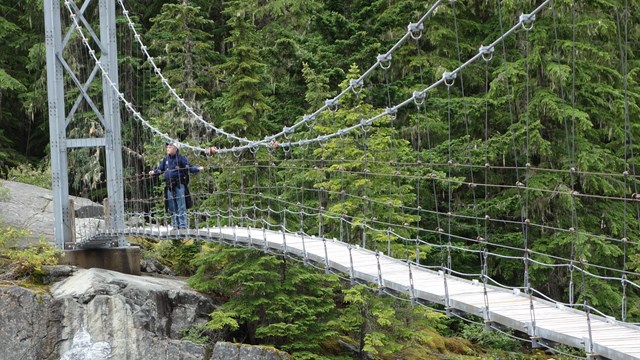
NPS Photo At Mount Rainier, bicyclists can enjoy bicycling that is both challenging and scenic. Bicycles are allowed on park roads but they are not permitted on any hiking trails and the park does not have any designated bike trails. September and early October are generally excellent times for bicyclists to visit Mount Rainier. During these months, there are usually fewer vehicles on the roads and fall colors enhance the scenery. However, many facilities and services are reduced or discontinued after Labor Day due to the probability of snowfall. Be aware that the park may temporarily close any road to bicycle use. Signs will mark closed roads and bicyclists can check current road status when planning a trip. Availability of bicycling equipment in or near the park is very limited and bicyclists should be prepared to make repairs on their own. For your safety, wear a helmet. Bicycling Safety & RegulationsPark roads are steep, narrow, winding and have unpaved shoulders. There are several significant elevation gains and losses. Bicyclists are advised to maintain safe speeds on downhill sections. While in the park, bicyclists are required to ride single file. Bicyclists may ride two abreast only on Westside Road and Carbon River Trail (former road), where vehicles are not allowed. However, please be aware of hikers also using those routes and yield to hikers. Most of the park does NOT have cell coverage. Please review additional bicycling safety guidelines and regulations for Mount Rainier National Park. Riding the RoadsCheck the Road Status page for current conditions. Many roads are closed and snow-covered during the winter. Nisqually Entrance - Paradise NE Entrance - Sunrise Carbon River Trail (former road) and Mowich Lake Road Westside Road** Using E-bikes at Mount Rainier National ParkE-bikes are now allowed everywhere traditional bicycles are allowed in Mount Rainier National Park. This includes all park roads currently open to motor vehicles. E-bikes possessing a motor of less than 750 watts (1 h.p) on which the motor only assists with pedal propulsion are permitted on roads and trails that are currently open only to bicycles, including the Westside Road to Klapache Point and the Carbon River Road from the Carbon River Entrance to Ipsut Creek Campground.
Visit our keyboard shortcuts docs for details
There are many ways to experience Mount Rainier National Park. Most visitors explore the park in vehicles or on foot, but why not by bike? Most of Westside Road is closed to vehicles, but is open to bicycling and hiking. Ride through old-growth forest, visit a historic ranger cabin and stonework bridges, and pause to remember the long history of the mountain. Road Status
Find out current road conditions, including access to Paradise during the winter season. 
Bicycling Safety & Regulations
Safety guidelines and regulations when bicycling in Mount Rainier National Park. 
Hiking Safety
No matter the length of your hike, being aware of risks can help make your hiking experience safe and enjoyable! |
Last updated: December 19, 2025
